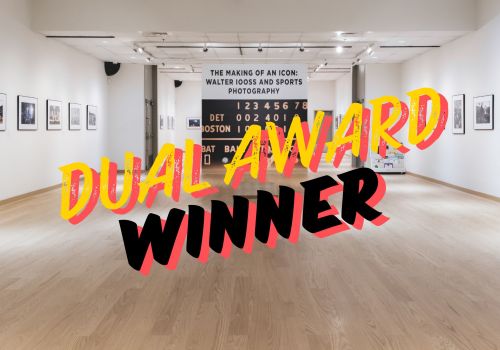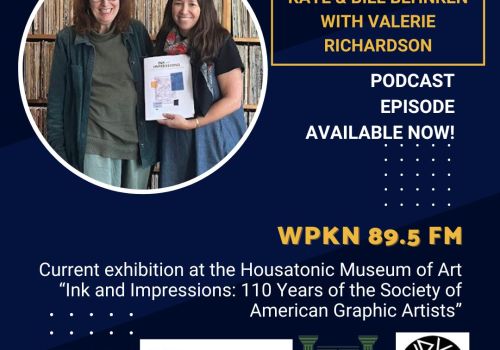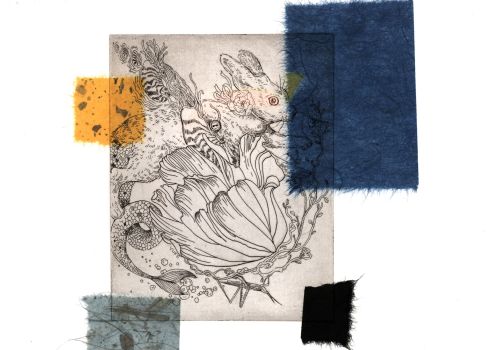
Illustrating Connecticut - Mystic Country

|
|
|
Brian Cronin Portugal; formerly New York City Seven People from Connecticut, 2007  Carbon and charcoal on printing paper, 27 x 22" Brian Cronin has selected a diverse group of people whose individual accomplishments and passions merge to create a single portrait of a Connecticut native replete with all the qualities and characteristics ascribed to the Connecticut "Yankee." Although she was driven from her hometown of Canterbury for educating young African-American women, Prudence Crandall (1803-1890) embodied the history of Yankee reform movements begun in 1800, including abolition, temperance, and women's rights and education. Samuel Colt (1814-1862) displayed Yankee ingenuity, starting out as an indentured servant on a Glastonbury farm, and through hard work and resourcefulness, amassed both fortune and fame by inventing the revolver and the repeating firearm. Anson Dickinson (1779-1852) of Milton practiced the art of portrait miniatures for his clients who were both celebrated and ordinary citizens. Miniatures were extremely popular before being supplanted by the new art of photography, and Dickinson, renowned in his own time, is largely forgotten. Born in Cheshire, Samuel Augustus Foote (1780-1846) served as Governor of Connecticut in 1834 and 1835. Henry Shelton Sanford (1823-1891) of Woodbury built his fortune manufacturing brass tacks, served as a Senator in the Connecticut Senate, was an American Diplomat, and founded the town of Sanford, Florida. During the Civil War, Sanford coordinated northern secret service operations, coordinated the purchase of supplies for the Union effort, and on behalf of Secretary of State William H. Steward, offered the Italian patriot Giuseppe Garibaldi a Union Command. Bristol native and Yankee soldier Austin David Thompson (no dates) enlisted in the Connecticut 16th Infantry on August 11, 1862. Promoted from private to corporal and then sergeant, he fought at Antietam, Edenton Road, Fredericksburg, and Providence Church Road, and was captured and held as a prisoner of war at Plymouth, North Carolina. Samson Occum (1723-1792) was an elected leader of the Mohegans, a Christian missionary, and a teacher. Although white society betrayed Occum by breaking promises about Native American land agreements, education, and community development, history has recognized his contributions. Acknowledged as the Father of Native American Literature, he founded Dartmouth College, and is revered to this day by the Brothertown Indian Nation and the Mohegan, Shinnecock, and Montauk people. Kelloggs & Comstock Steam Works of the Hayward Rubber Company, 1848-1850  Lithograph; printer’s ink on wove paper, 177/8; x 22" The Industrial Revolution coupled with the decline of the whaling business brought workers to Colchester, Connecticut. The population doubled with the opening of three tanneries and a woolen mill (1819), a hatter (1828), a wheel and carriage factory (1858), a paper mill (1869), a creamery (1886), and a canning company (1893). The Hayward Rubber Company was established in 1847 by Nathaniel Hayward who, with Charles Goodyear, discovered the process of vulcanized rubber. The company manufactured rubber boots and shoes that were shipped throughout the country until its close in 1893. This promotional print was published by Kelloggs & Comstock of Hartford who, from 1830 until the end of the century, was the second largest producer of decorative prints for the American market behind Currier and Ives. Walter O. R. Korder (1891-1962) Hartford, Connecticut New London’s Whaling Industry, c. 1940 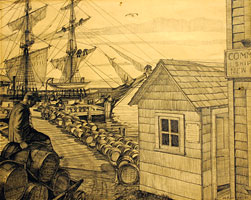 Pencil, 12 x 15" New London, Connecticut, founded in 1646 by John Winthrop, Jr., became an important port in Colonial America because of its protected harbor at the mouth of the Thames River, and it served as the base of American naval operations during the Revolutionary War. With its access to Long Island Sound, New London was America's third leading whaling port behind New Bedford and Nantucket, boasting over 30 ships and 900 whalers in 1834. Walter O. R. Korder (1891-1962) Hartford, Connecticut Simon Lake Builds Submarines, c. 1940 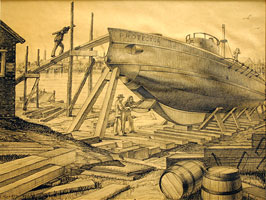 Pencil, 12 x 15" American engineer and naval architect, Simon Lake (1866-1945) founded the Lake Torpedo Boat Company in Bridgeport, Connecticut, in 1912, and built 24 submarines for the U.S. Navy during and after World War I. Although Lake was born in New Jersey, he nevertheless exhibited Yankee ingenuity by obtaining over two hundred patents for advances in naval design and by competing with John Holland to build the first submarines for the United States Navy. Ross MacDonald Newtown, Connecticut Fox, 2004 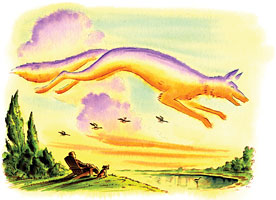 Watercolor and pencil crayon, 12 x 18" This illustration, which appeared on the cover of the Connecticut section of The New York Times in May 2004, brings to mind the story of Israel Putnam who killed the last wolf in Connecticut in December 1742. Putnam and other farmers pursued the wolf which had preyed on their sheep and goats, cornering it after an overnight chase in a den in Pomfret, Connecticut. Putnam, with a rope tied around his legs so he could be pulled to safety, crawled into the den and shot the wolf with his rifle. The wolf den is located in Wolf Den State Park in Pomfret. Putnam later distinguished himself at the Revolutionary War Battle of Bunker Hill in 1775. Hal Mayforth Montpelier, Vermont A Goin’ to Glory, 2003 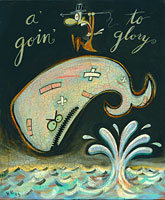 Acrylic on wood panel, 24 x 20" The sperm whale was selected as our state animal by the General Assembly in 1975 in recognition of the history of whaling in Connecticut and its present-day status as an endangered species. During the 1800s, Connecticut ranked second only to Massachusetts in the American whaling industry with numerous ports, including New London and Mystic. The sperm whale was the species most sought after for oil for lamps and other products. Wendell Minor Washington, Connecticut Trail Wood - Edwin Way Teale House, 2004 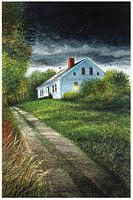 Watercolor , 10 ¾ x 7" Edwin Way Teale (1899-1980) was one of the best-loved naturalists of his generation. As a writer, he has been ranked with Henry David Thoreau, John Muir, and John Burroughs. He was also an accomplished photographer who pioneered new techniques for creating close-up images of insects and other living things. In 1959, he and his wife Nellie left the increasing suburbanization of their Long Island home for a 130-acre wooded estate in Hampton, Connecticut, which they named "Trail Wood." This became the subject of one of Teale’s most popular books, A Naturalist Buys an Old Farm (1974). Among Teale’s many other books are The Insect World of J. Henri Fabre (1949), North with the Spring (1951), Circle of the Seasons (1953), and Wandering Through Winter (1965), for which he won the Pulitzer Prize. After Nellie Teale’s death in 1993, Trailwood passed to the Connecticut Audubon Society which maintains it as a public sanctuary and a memorial to two remarkable individuals and their appreciation for the natural world. Christopher Passehl Essex, Connecticut Benedict Arnold, 2007 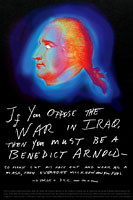 Archival ink jet on Somerset velvet, 14 x 20 ½" Benedict Arnold (1741-1801) is best known for his traitorous acts against General George Washington during the Revolutionary War. He was born in Norwich, Connecticut, into prominent New England families. With the failure of his father’s business ventures, he was withdrawn from school and apprenticed to an apothecary before establishing his own apothecary and shipping business in New Haven. His military career began with his service in the army during the French and Indian War. He served for the American cause during the Revolutionary War with some success that was tinged with failure and disreputable behavior. He felt embittered by his perceived lack of recognition by Congress and the Continental Army, and in 1780, plotted with the British to turn over the strategically-important West Point stronghold for a payment of 20,000 pounds. The plans collapsed when his British counterpart was captured and hung. Arnold sought refuge with British forces who appointed him a brigadier general, and he escaped to England after the war. Garrett Price (1896-1979) Westport, Connecticut Ivoryton Playhouse, c. 1951  Gouache on paper, 15 x 11 ½" The Ivoryton Playhouse, Ivoryton, Connecticut, was the first self-supporting summer theater in the nation, and was built as an employee recreation center by the Comstock-Cheney factory in 1908. Katherine Hepburn, Cliff Robertson, Marlon Brando, Helen Hayes, and Groucho Marx, to name a few, performed there. The playhouse continues to provide first-class, year-round theater programs. Jeff Seaver Westport, Connecticut Birdsong, 2003 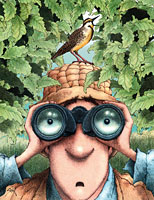 Pen, ink, and colored pencil on Bristol board, 10 ¾ x 8 ¼" The Audubon Society was founded over one hundred years ago to protect birds from hunters who sold their feathers for use on hats and clothes. Birdsong was commissioned by National Wildlife Magazine with the Audubon Society to encourage bird watching in Connecticut. Birds and wildlife continue to be threatened today by uncontrolled development that fragments or destroys their habitat. |
|

